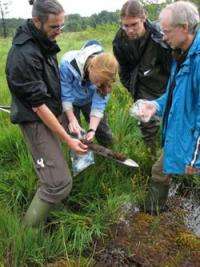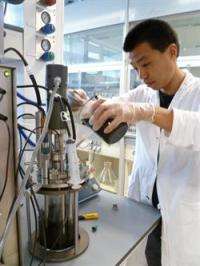New peatland bacteria feed on greenhouse gas and excess fertilizer, study finds

Researchers from Radboud University Nijmegen and B-WARE Research Centre have discovered new methane-consuming bacteria in the soil beneath the Brunssummerheide peatland reserve in Limburg, the Netherlands. Although the bacteria may be the result of environmental pollution, they are now consuming the harmful greenhouse gas. Applied and Environmental Microbiology has published the results in its December issue.
In the middle of the Brunssummerheide heathland reserve is a unique sloping peatland site with a great diversity of flora and fauna, such as the rare Bog Asphodel and the protected Northern Emerald dragonfly. The variety of landscape types within a small area means that it is vulnerable to water level and water quality changes. Dutch nature conservation association Vereniging Natuurmonumenten therefore wants to know how to best manage and protect the area, and called on the help of B-WARE Research Centre and Radboud University Nijmegen in 2008.
Methane filter
Gijs van Dijk, the aquatic ecologist who took on the job, made a remarkable discovery. 'I found high concentrations of methane, also called marsh gas, deep in the peat section, but detected none at the surface. The anaerobic peat soil was therefore effectively filtering out the methane - but how?' This question has been solved by Katharina Ettwig, microbiologist at Radboud University Nijmegen.

Soil research
Ettwig had already shown that special bacteria can oxidise methane anaerobically using nitrogen compounds such as nitrites and nitrates. 'However, the process had never been seen outside the laboratory', explains Ettwig. Following intensive soil and laboratory research (see Figures 1 and 2), the methane filter in the Brunssummerheide peatland reserve was discovered to be the work of a new type of bacteria, a close relative to the previously-discovered Methylomirabilis oxyfera. The bacteria make pure oxygen from nitrites and use this to 'burn' the methane, providing the bacteria with its source of energy.
Ideal conditions
Every anaerobic peat soil contains methane. However, the groundwater in the Brunssummerheide peatland reserve also contains unusually high levels of nitrates, probably due to leaching from woodland and agricultural soils. This combination of methane, nitrate and the presence of oxygen in the Brunssummer peat provides ideal conditions for the Methylomirabilis bacteria. The bacteria are therefore already found in methane and nitrate-rich soils: nature conservationists do not need to introduce them. Natuurmonumenten will therefore mainly use this information to monitor groundwater pollution and, where possible, to tackle it at the source.
Applications for methane-eaters
The researchers are currently investigating whether the global increase in nitrogen pollution is also reducing methane emissions in other ecosystems. They are also looking into the cell biology and biochemistry of the bacteria to find out if it has any practical applications, such as in water treatment. The Nijmegen Institute for Water and Wetland Research (IWWR) research group has a great deal of experience in cultivating, studying and finding applications for slow-growing, anaerobic bacteria. During previous joint research projects, they discovered the anammox bacteria and the methane-consuming volcano bacteria.
More information: aem.asm.org/content/78/24/8657.short
Journal information: Applied and Environmental Microbiology
Provided by Radboud University Nijmegen


















